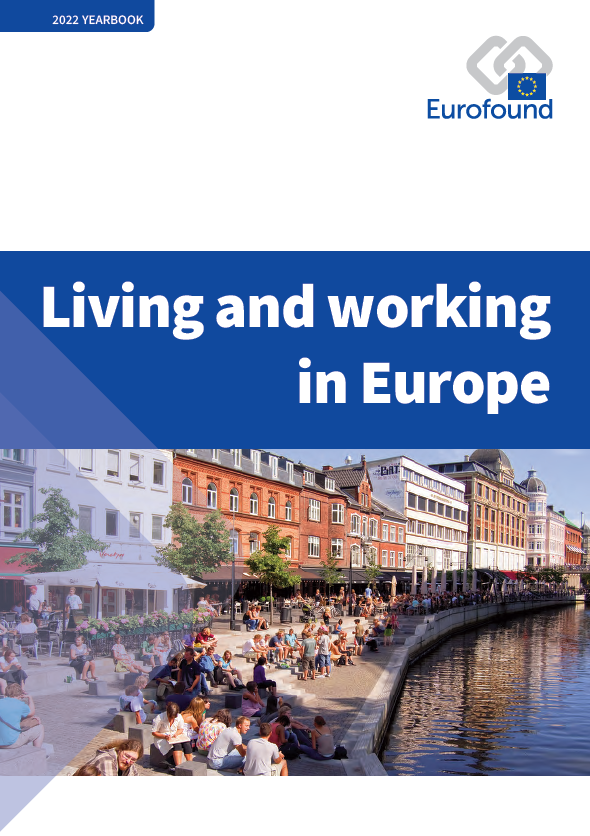
Úvod roka 2022 priniesol opatrný optimizmus. Európa sa vymanila z dvoch rokov pandémie ochorenia COVID-19, pričom v nástroji NextGenerationEU sa stanovuje plán obnovy, ktorým sa buduje silná a udržateľná budúcnosť. Ruský útok na Ukrajinu začiatkom roka však túto situáciu dramaticky zmenil a vyvolal ďalší zmätok na celom kontinente. Nadácia Eurofound v rámci svojej činnosti počas roka zdokumentovala vplyv rastúcich životných nákladov a iného vývoja vyplývajúceho z vojny na dobrú hospodársku a psychologickú situáciu Európanov. V tejto ročenke 2022 sú zhrnuté aj zistenia z prieskumu agentúry o pracovných podmienkach počas pandémie, jej správy o trendoch v oblasti zamestnanosti a jej štúdie o možnej úlohe sociálneho dialógu v rámci zelenej a digitálnej transformácie. Výskum nadácie Eurofound o pracovných a životných podmienkach v Európe poskytuje základný zdroj dôkazov, ktorými sa prispeje k tvorbe opatrení v oblasti sociálnej politiky a dosiahnutiu vízie agentúry „byť hlavným zdrojom poznatkov Európy pre lepší život a prácu“.
The report contains the following lists of tables and figures.
List of tables
Table 1: Top three jobs with biggest employment losses, EU27, Q4 2019–Q4 2021
Table 2: Top three jobs with biggest employment gains, EU27, Q4 2019–Q4 2021
Table 3: Top 6 retail banking occupations in 2011 and 2021, EU27
Table 4: Job demands and job resources included in the EWCTS 2021
List of figures
Figure 1: Employment level (in thousands), by quarter, EU27, 2019–2021
Figure 2: Year-on-year change in actual weekly hours worked, EU Member States, Q4 2020–Q4 2021 (hours)
Figure 3: Year-on-year change in the unemployment rate (percentage points), by age group, EU27, 2020–2021
Figure 4: Employment shifts in job–wage quintiles (millions), EU27, Q4 2019–Q4 2021
Figure 5: Employment shifts in job–wage quintiles (millions), by gender, EU27, Q4 2019–Q4 2021
Figure 6: Year-on-year changes in employment across sectors, by gender, EU27, Q4 2020–Q4 2021 (%)
Figure 7: Job vacancy rates, by sector, EU27, Q4 2022 (%)
Figure 8: Total number of announced job losses and job gains, EU27, February–December 2022
Figure 9: Number of cases of announced job loss and job gain in financial services, EU27, 2008–2021
Figure 10: Number of bank branches per 100,000 inhabitants, EU Member States, 2004 and 2020
Figure 11: Prevalence of telework, retail banking and other sectors compared, EU27, 2008–2021 (%)
Figure 12: Changes in minimum wages in real terms, EU Member States, January 2021–January 2022 (%)
Figure 13: Proportion of EU employees earning minimum wages, by sector and occupation, 2018 (%)
Figure 14: Private sector collective bargaining coverage, EU Member States, 2019 (%)
Figure 15: Private sector collective bargaining coverage and predominant level of agreements, EU27, 2019 (%)
Figure 16: Job quality breakdown by sector, EU27 (%)
Figure 17: Exposure to high level of physical risks, by sector, EU27 (%)
Figure 18: Exposure to types of intimidation, by sector and gender, EU27 (%)
Figure 19: Expected undesirable change in workplace situation, by sector, EU27 (%)
Figure 20: Workers who work 48 hours or more per week, by sector, EU27 (%)
Figure 21: Health and safety at risk because of work, by sector, EU27 (%)
Figure 22: Poor fit between working hours and family and social commitments outside work, by sector, EU27 (%)
Figure 23: Degrees of autonomy, influence of computerised system and a supervisor compared, EU27 (%)
Figure 24: Preferred frequency of working from home, by gender, EU27, 2022 (%)
Figure 25: Workers with poor work–life balance, by gender and telework arrangement, EU27, 2021 (%)
Figure 26: Employees working from home, by occupational group, EU27, 2020 (%)
Figure 27: Share of full-time employees working long weekly hours, by telework arrangement, EU27, 2021 (%)
Figure 28: Share of full-time employees who worked during their free time, by telework arrangement, EU27, 2021 (%)
Figure 29: Working time preferences, by usual weekly working hours, EU27 (%)
Figure 30: Unpaid work activities, by gender, EU27 (%)
Figure 31: Paid and unpaid hours of work among women, by number of children, EU27
Figure 32: Paid and unpaid hours of work among women and men, by number of children, EU27
Figure 33: Well-being scores, by age group, 2020–2022
Figure 34: Prevalence of negative feelings, by age group, EU27, 2020–2022 (%)
Figure 35: Prevalence of risk of depression, by age group, EU27, 2020–2022 (%)
Figure 36: Ability to make ends meet by level of difficulty, EU27, 2020–2022 (%)
Figure 37: Unmet healthcare needs of respondents with and without disabilities, EU27, 2021 (%)
Figure 38: Unmet healthcare needs, by type of healthcare, respondents with and without disabilities compared, EU27, 2021 (%)
Figure 39: Risk of depression and loneliness, respondents with and without disabilities compared, EU27, 2021 (%)
Figure 40: Arrears, by type of healthcare, respondents with and without disabilities compared, EU27, 2021 (%)
Figure 41: Trust in institutions – mean scores (scale 1–10), 2020–2022, EU27
Figure 42: Trust in national government by ability to make ends meet (scale 1–10), 2020–2022, EU27
Figure 43: Performance of EU on six World Governance Indicators, 2008–2020
- Number of pages
-
72
- Reference nº
-
EF23016
- ISBN
-
978-92-897-2323-7
- Catalogue nº
-
TJ-AM-23-001-EN-N
- DOI
-
10.2806/063917
- Permalink
Cite this publication
Eurofound (2023), Living and working in Europe 2022, Publications Office of the European Union, Luxembourg.